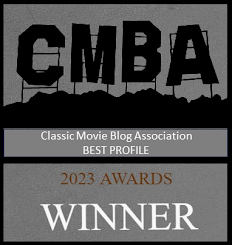For those who have not seen it, the plot revolves around three characters: ballet company impresario Boris Lermontov (Anton Walbrook), ballerina Vicky Page (Moira Shearer), and composer Julian Craster (Marius Goring). Each is dedicated to the musical arts, but to varying degrees.
 |
| Anton Walbrook as Lermontov. |
Julian is dedicated to his music. He wakes up in the middle of the night thinking about it and rushes to the piano to transcribe it. However, Julian can balance his profession and his personal life, especially after he falls in love with Vicky.
Vicky is torn between her need to dance and her love for Julian. Like Lermontov, she is obsessed with ballet and cannot live without it. Yet, she loves Julian passionately and cannot envision a life without him. When circumstances prevent her from dancing for Lermontov's company and being with Julian, Vicky confronts an existence that's burning from both ends.
While the characters portray the conflict between art and "real life," director Michael Powell visualizes it for the audience. The centerpiece of The Red Shoes is an audacious original ballet that literally pulls the viewer from the audience into an imaginary world. Powell opens the scene showing the curtains drawing back to reveal a solitary dancer, a shoe cobbler holding red ballet slippers, on the stage. Then, he cuts to a shot of the village that crops out the framing of the stage. The viewer is now on the stage with the performers and immersed into their world.
 |
| Vicky dancing with a newspaper man. |
 |
| The controlling ballet shoes. |
Anton Walbrook is the standout among the cast. In his third Powell-Pressberger film, Walbrook gets a chance to portray a complex character that straddles the line between supportive and manipulative. Lermontov is an unforgiving taskmaster, but he recognizes artistic brilliance and supports it. When Vicky wants to leave the ballet company to be with Julian, Lermontov releases her from her contract. But when given a chance to see her again, he pressures her to come back into the fold. He wants to be gracious, but ultimately he must do what he feels is right for the ballet company.
Do I now rank The Red Shoes over Black Narcissus? No, the latter is still my favorite Powell & Pressberger film. But I am glad I watched The Red Shoes again. I have grown to admire its dazzling colorful imagery, Powell's bold directing, and the film's exploration of the thin line between real world and the fantasy world created through visual and aural artistry.









I enjoyed your write-up, Rick. Maybe I'll give The Red Shoes another chance as well.
ReplyDeleteI have loved P&P since watching Black Narcissus years ago and being astonished by the direction, writing, and cinematography. Since then I've seen almost all of Michael Powell 's movies and read his 2 autobiographie as well as 200,000 Feet on Foula. Became a fangirl essentially lol. I have to say all my favorites are from the WWII years. I admire Red Shoes and BN but I adore I Know Where I'm Going and especially A Canterbury Tale (it's so different than any other WWII film and such a personal film for Powell and my favorite Eric Portman performance).
ReplyDeleteI also love I Know Where I'm Going--such a charming film and Wendy Hiller is luminous. I'll also put in a plug for The Life and Time of Colonel Blimp, which provide Deborah Kerr with three great roles. A Canterbury Tale is my favorite of their World War II films, too.
ReplyDeleteSuch a nice, inviting review, w/great info! Now I want to rewatch The Red Shoes yet again (it's been quite a while), as it isn't even in my top 5 P&P films. Colonel Blimp is probably their true masterwork—surprising it isn't more well known by a general audience, at least in the States—but not a top 5 of mine either. Black Narcissus is without a doubt my favorite. Also love I Know Where I'm Going & Canterbury Tales (so cool to see the town and cathedral at that time.) Also love The Tales of Hoffman—despite initial disappointment in their altering certain elements of Offenbach's fantastic opera. Thank you for your review here!
ReplyDeleteWhat a thoughtful and engaging review! It’s inspired me to revisit The Red Shoes—it’s been quite a while since I last saw it, and oddly enough, it’s not even in my top five Powell and Pressburger films. For me, The Life and Death of Colonel Blimp is likely their true masterpiece—though it’s surprising it hasn’t gained wider recognition, especially in the U.S. Still, it doesn’t quite make my personal top five. My absolute favorite has to be Black Narcissus. I also have a deep appreciation for I Know Where I’m Going and A Canterbury Tale—it’s fascinating to see the town and cathedral as they were back then. The Tales of Hoffmann is another gem, despite my initial surprise at how they altered certain aspects of Offenbach’s brilliant opera. Thanks again for sharing this wonderful review! For more such thoughtful pieces, check out Jeetwin News.
ReplyDeleteI've had little interest in these films 'til now, but have become intrigued after reading the review here. I'm downloading the Powell & Pressberger documentary now and look forward to watching it.
ReplyDeleteI love all the Powell/Pressburger films — even the “little” “The Small Back Room”, and Powell’s solo career-destroying “Peeping Tom” — and would have to say “The Red Shoes” is my favorite. I’ve had a few friends and acquaintances over the years who insist that Lermontov’s character was a classical chauvinist, unable to see that a woman could have a private life AND a career, but I disagree — do any of his male colleagues have a discernible personal life? I think he demands that “fidelity” to art from everyone in his circle, irrespective of gender, and that proves to be his downfall — and, tragically, Vicky’s as well. And, oh my, Anton Walbrook is magnificent…
ReplyDelete